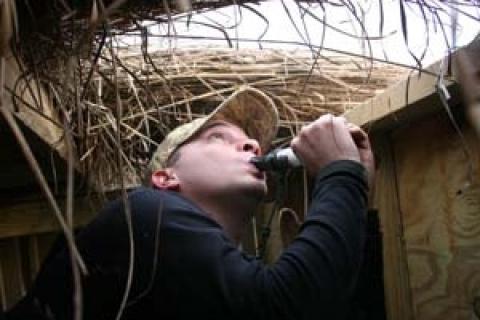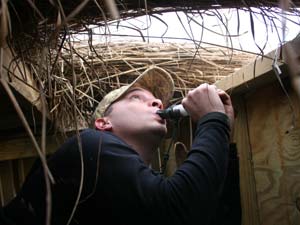
Pulling ducks and geese over long distance is perhaps the ultimate challenge in hunting these birds! Working waterfowl that are in-close-and-looking requires great skill, no doubt. But capturing their attention and drawing them in over extreme distances of water, marsh or field is the supreme test for callers. Those who can do this consistently are the virtuosos of this sport.
 |
| Loud, persistent calling can turn ducks farther than most hunters believe. |
Scobey, Californian Ken Susnara, Virginian Teddy Carr and Missourian Tony Vandemore are four such callers. Each understands the possibilities and rewards of long-range calling. Each also knows techniques for luring these birds from the next time zone. Other hunters who apply their advice and master their methods can take advantage of this new calling plan: unlimited range and air time. All you need is enough breath to make it happen!
Glynn Scobey: Continuing the Reelfoot Tradition
Reelfoot Lake in northwest Tennessee is home for some of the best long distance duck callers anywhere. Generations of Reelfoot guides and local hunters have blown big wooden calls with metal reeds designed to lure ducks down from the heavens. Glynn Scobey has hunted this lake and shared in this tradition for more than six decades. He's also made and sold Reelfoot-style calls for 39 years. He says the calling system developed here will work on long-range ducks anywhere.
He remarks, "People ask me what's the difference in a call with a plastic reed and one with a metal reed, and I tell 'em, 'About a half a mile.' Seriously, you can hear that metal reed almost a mile across open water if conditions are right, and if the ducks can hear it this far, some are going to come to it."
Scobey says the secret to Reelfoot-style calling is a combination of loud volume; high pitch; piercing metal-reed notes; and almost-nonstop highballing. Scobey says this method requires a lot of lung power, but when done properly, it will usually out-pull plastic-reed calls by a wide margin.
He explains, "When you see ducks at a distance, you starting blowing a series of fast, high notes (the "Reelfoot highball"). You blow 20-30 notes - as many as you can before you run out of breath. Then you suck in more air and go again. You keep this up until the ducks pitch or they're gone."
Scobey says this loud, staccato-style of calling doesn't sound natural up close, but it obviously sounds good to ducks at a distance. "It's got a mesmerizing effect. You can grab ducks' attention and guide 'em in like they're following a homing beacon. It just does something to them that's hard to explain until you see it."
Sometimes Scobey calls in tandem with another caller, but one takes the lead while the other plays backup. "There should just be one caller highballing. The other caller might fill in with some feed chuckles or close-in quacks. But I believe having two callers highballing can confuse the ducks. Instead, it's better to have them lock onto one lead call and follow it in."
Scobey calls his birds all the way to the gun. "If you stop calling, somebody else is going to get'em," he explains. "Also, if they've come to you from long distance, they like what they're hearing, so why stop? When ducks get close, I tone down the volume, but I keep going with the call. I don't let up until I raise my shotgun."
Ken Susnara: Pacific Flyway Approach
The California method of calling ducks at long distance is a little more conventional than the Reelfoot method, based on the description given by Ken Susnara of Redwood City, Calif. This two-time state duck calling champ hunts mostly over open water and flooded rice and barley fields. To him, "long distance" means birds that are 600-700 yards away and showing signs of wanting to work. "I don't bother trying to call way-off birds or flights that are obviously traveling somewhere else," he explains.
Susnara wears two Betts acrylic Arkansas-style calls around his neck, one for long-range calling and the other for close-in work. The long-range call has a louder volume and higher pitch than its counterpart.
 |
| Long-range callers command waterfowl to come instead of inviting them to. |
When he sees a flight with the right look, Susnara commences hailing them with 12-15 note highballs prefaced by one or two elongated notes to grab the birds' attention. Then he shifts his hail call to shorter, standard notes. He repeats this highball until the flight pitches or flies on. If the ducks break his way, he transitions to a greeting call by speeding up his cadence.
"This is when I switch from contest-type calling to sounding more ducky," Susnara continues. "As the ducks get progressively closer, I'll alternate between shorter greeting calls, lonesome hen calls and feeding chatter. I back way off on my calling when I know they're committed. But if they show the first sign of wavering, I'll jump back on them. I'll throw everything I've got at them to persuade them to lock back in."
Susnara also varies his calling style according to weather conditions, particularly wind. "I'll blow a lot louder and longer on distant birds on a high-wind day. But if it's foggy or a calm bluebird day, I don't call nearly as much."
Susnara also believes two callers can have more attraction to long-range ducks "as long as they don't blow on top of each other. You and your partner just have to learn to stay in sync with each other, one starting up as the other comes down. You learn this by hunting together and getting used to each other's calling style."
Teddy Carr: Interrupt Ducks' Game Plan
Teddy Carr of Locust Grove, Virginia runs a business called Outdoor Action guide service. In the winter he guides waterfowl hunters from a permanent blind on a tidal tributary of the Potomac River. "I'm mainly hunting open water and competing with a lot of other callers," Carr says. "This means I've got to be louder and more persuasive than the others to pull birds my way."
Carr says long-range duck calling is "all about getting the sound to the birds. You need loud volume and a high-pitch call to reach further." A Knight & Hale pro staffer, Carr prefers a K&H T Lock Single Duck (single reed) acrylic call for longer distances. "You can put a lot of air through this call without it breaking," he explains. "It also has a hard, crisp note, and that's important."
Carr calls at ducks as far as he thinks they can hear him — up to 400 yards with the wind at his back. He points the call directly at the birds. "Many hunters look at the ducks, but they call at the water," he says. "Point that call right at them. You don't want the sounds echoing off the water or surrounding hills or trees. You want those ducks to get a direct line to where the sounds are coming from. I'd say not blowing straight toward the ducks is the number one mistake callers make when calling over long distance."
Carr's main long-range call is a greeting call — five to seven notes that start loud and scale down with each note. "I'm looking for impact," he explains. "I call this my 'lock-up call'. When ducks have that right look, I'll blow this greeting. I'm trying to grab their attention. I want to interrupt their game plan for the day, and that greeting call is my ace-in-the-hole."
Carr concludes that when it comes to long distance calling, "confidence is everything. You can't be afraid to make mistakes. Just give them all you've got and learn as you go. A duck hunter's life changes when he turns that first flight at long distance. He learns what's possible, and his confidence starts to grow, and then he begins working ducks he never thought he had a chance at before."
Tony Vandemore: Tailor Goose Calling to Situation at Hand
Tony Vandemore of Kirksville, Mo., hunts two types of locations for Canada geese: on the "X" (the precise spot where geese are coming to feed); and in a "traffic field," not specifically where geese are coming but within visual proximity to a high-use flight lane.
When hunting the X, this Avery pro-staffer calls and flags very little. "If you know they're zeroed in on your spread, you don't need to give them much encouragement, just an occasional pop with the flag and maybe a little clucking or moaning for a natural effect. Just be patient and let them come on."
But when he's hunting a traffic field, he reverses this subtle approach to draw birds over long distances. "Now you've got to convince them to change course and come to you, and this takes a lot of persuasion with the flag and the call. Calling geese to a spread on a traffic field is much more forceful. You get on them and stay on them to keep them locked and coming."
Vandemore says the flag is his first long-range "caller". "Geese can see a lot farther than they can hear, and if you can see them, they can see you." When he spots a flight at long range, Vandemore and his partners begin flagging aggressively, mimicking geese that are landing. "We hold it high and flap it, then bring it down. It's hard to flag too much when the birds are a long way off."
Vocal calling accompanies the flagging as soon as the geese can possibly hear the calls. "I prefer a high-pitch short-reed call for long distance," Vandemore continues. "The higher-pitched sounds cut the wind better and can be heard farther.
"I start out with long range greeting calls blown fairly fast. I'll experiment with high-to-low and low-to-high to see what they're responding to best. And as I call, I watch the whole flock. I'll look for that one bird that's responding the best, maybe starting to sail a little bit. Once I identify that one goose, I'll call to that bird only and forget about the others. If I can get that goose to lock up and come, chances are the others in the flock will follow him."
When the birds get closer, Vandemore builds excitement by switching to fast double-clucking. He explains, "On traffic fields, a lot of times the faster the calling, the faster they'll drop. You just grab their attention and don't let go."
Vandemore continues, "As long as they're locked up, I stay with what I've been blowing. However, if they check up or start showing some hesitation about coming, I'll change my calling style to try to lock'em back up. You just have to read your birds and determine what they like best, then stick with that style."
Also, when traffic field geese are committed, Vandemore changes to "more technical flagging." "We'll cut back on the amount of flagging and make it look more realistic, like a bird on the ground flapping its wings. When they get in close, I don't like to risk scaring them with the flag. I just want to show a little movement for the sake of realism."
What about double calling on long range geese? "One caller should be the lead caller," Vandemore says. "Other callers might join in for more volume and excitement, but they shouldn't do what the lead caller is doing or cover up his calling. Other callers should compliment what the lead caller is doing, not distract from it. He's brought the birds from long distance, and he should be the main one to seal the deal."
- 6082 views

